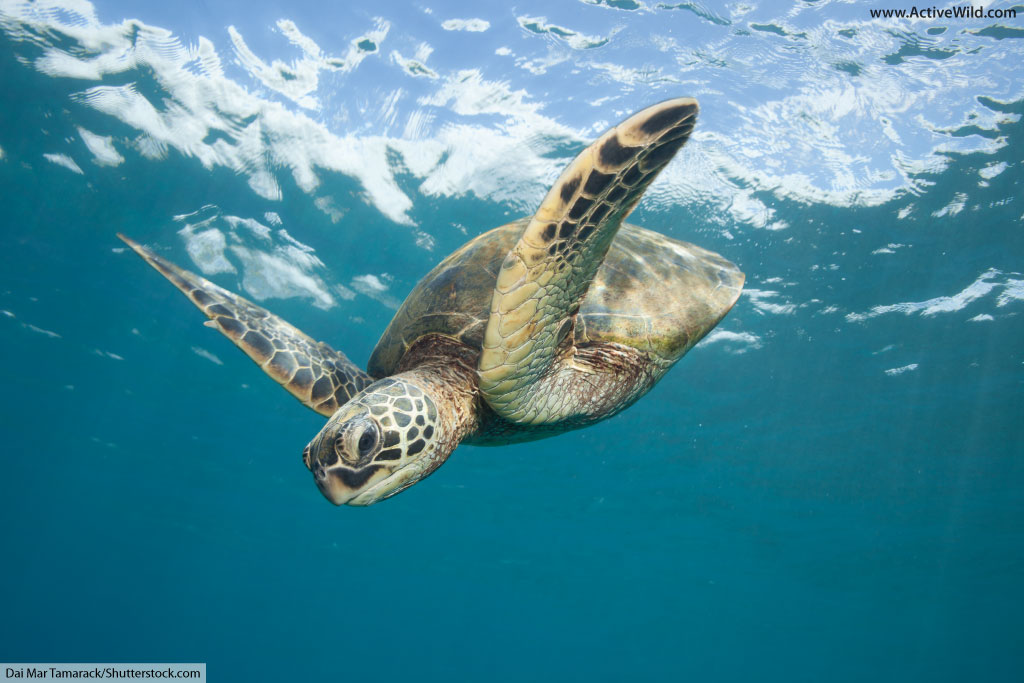

Turtles can rest or sleep underwater for several hours at a time, but submergence time is much shorter while diving for food or to escape predators.Through these crystals, they can sense the intensity of Earth's magnetic field and are able to make their way back to their nesting grounds or preferred feeding grounds. They can detect magnetic information by using magnetic forces acting on the magnetic crystals in their brains. The sea turtles also contain an internal magnetic compass. In the open ocean, they navigate using wave directions, sun light, and temperatures. Since green sea turtles migrate long distances during breeding seasons, they have special adaptive systems in order to navigate.The males also return to their birthplaces in order to mate. Their ability to return to their birthplace is known as natal homing. Sea turtles return to the beaches on which they were born to lay their own eggs.Many islands worldwide are known as Turtle Island due to Green sea turtles nesting on their beaches.Green sea turtles migrate long distances between feeding sites and nesting sites some swim more than 2,600 kilometers (1,600 mi) to reach their spawning grounds.They bite off the tips of the blades of seagrass, which keeps the grass healthy. Adult Green sea turtles feed mostly on various species of seagrasses.As adult turtles, males are easily distinguishable from females by having a longer tail (visibly extending past the shell) and longer claws on the front flippers. Male and female Green sea turtles differ by their development and appearance.The name of this species refers to the usually green fat found beneath its carapace, not to the color of its carapace, which is olive to black.Seagrass beds also act as nurseries for a number of species of fish and invertebrates, many being of considerable value for commercial fisheries and thus important for human food security. Seagrass eaten by the turtles is quickly digested, becoming available as recycled nutrients for the many species of animals and plants that live in the ecosystem of seagrass. Green sea turtles eat seagrasses and algae, thus serving (much like mowing a lawn) to maintain the seagrass beds in a healthy state, making them more productive.

Overall, currently, this species is classified as Endangered (EN) on the IUCN Red List and its numbers today are decreasing. Population numberĪccording to the Sea Turtle Conservancy resource the total population size of nesting Green sea turtles is around 85,000-90,000 individuals. Increased effluent, contamination from coastal development, and over-harvesting of algae all threaten the habitat of the green sea turtle. Beach armoring, building works, and sand extraction degrades the nesting habitat, while light pollution in the nesting areas fatally attracts hatchlings so that they do not head for the sea. The main threats to these turtles include the degradation and loss of habitat, consumption of their eggs and meat, capture as bycatch, pollution, and climate change. These young turtles are rarely seen as they swim in deep, pelagic waters. Turtles spend most of their first five years in convergence zones within the bare open ocean that surrounds them. The salt marshes and seagrass beds contain seaweed and grass vegetation, allowing ample habitat for the sea turtles. The coral reefs provide red, brown, and green algae for their diet and give protection from predators and rough storms within the ocean. In these protected shores and bays, the green sea turtle habitats include coral reefs, salt marshes, and nearshore seagrass beds. Entire generations often migrate between one pair of feeding and nesting areas. Adults frequent inshore bays, lagoons, and shoals with lush seagrass meadows. Mature turtles spend most of their time in shallow, coastal waters with lush seagrass beds. Green sea turtles move across three habitat types, depending on their life stage. They are also found in the Caribbean Sea and parts of the Mediterranean, and throughout the warmer waters of the Pacific and Indian Oceans. Green sea turtles live in the Atlantic Ocean, ranging from the eastern part of the United States along the coast of South America and over to South Africa. Antarctic, Neotropical, Palearctic, Nearctic, Oceanian, Australasian, Indomalayan, Afrotropical


 0 kommentar(er)
0 kommentar(er)
